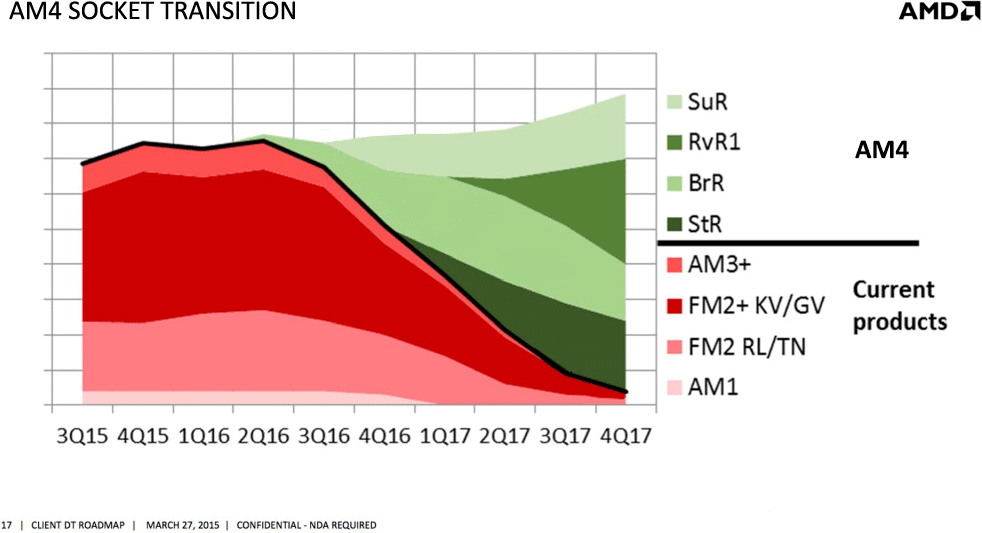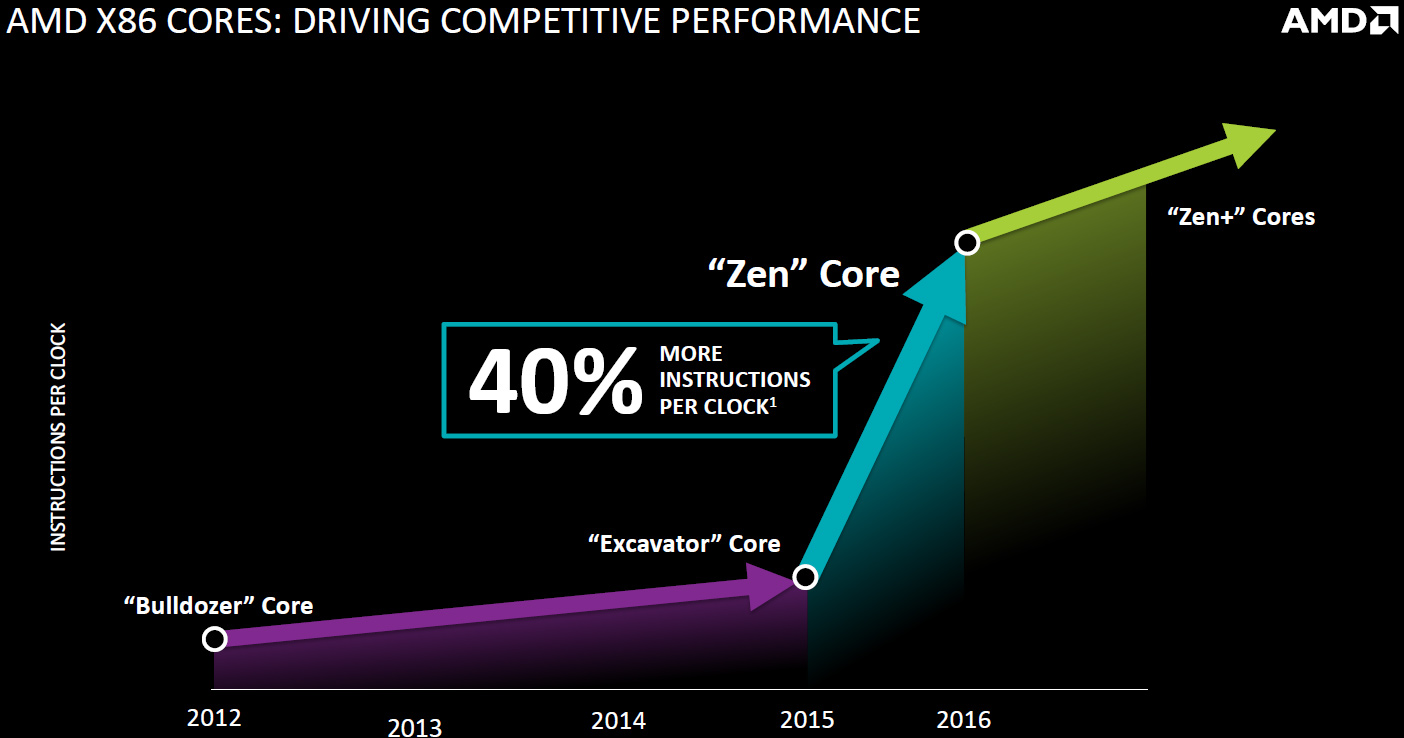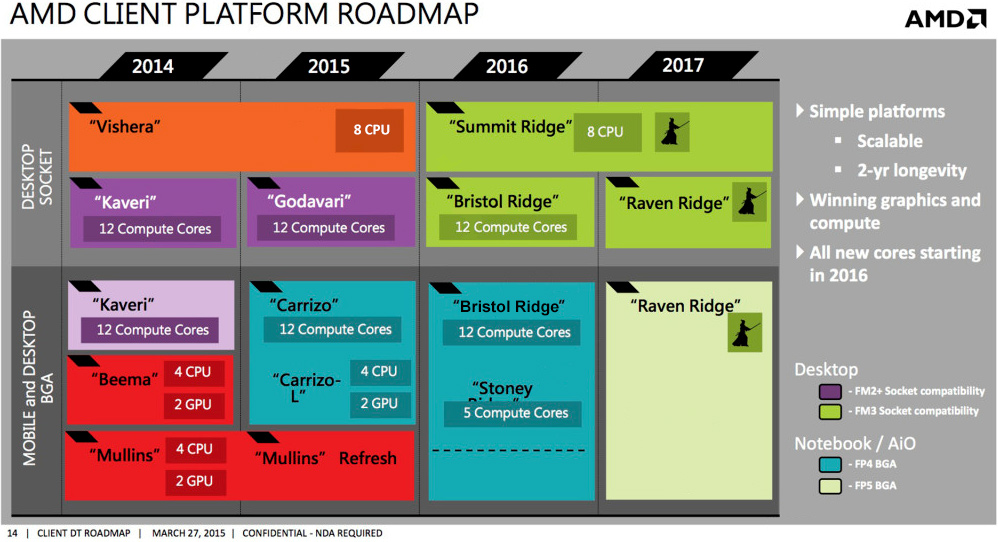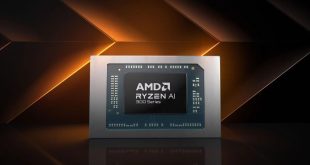Advanced Micro Devices’ next-generation “Zen” micro-architecture promises to significantly increase performance of the company’s central processing units next year. Even though AMD will introduce high-end microprocessors based on “Zen” in 2016, it will take a long time before a significant share of AMD’s chips will adopt its new architecture.
AM4 platform: One size fits all
As reported, starting next year all new AMD microprocessors will use the AM4 form-factor, which was previously known as the FM3 micro-PGA [pin-grid array] packaging. Platforms with the AM4 socket will rely on the code-named “Promontory” chipsets and will support DDR4 memory. Various versions or “Promontory” core-logic sets will power numerous solutions aimed at completely different market segments.
Based on alleged socket transition guide published by BenchLife web-site, the first mainboards featuring the AM4 socket will hit the market in Q2 or Q3 2016. It will take around 1.5 years before AM4 platforms will replace existing AM3+, FM2, FM2+ and AM1 platforms.

Unification of desktop infrastructure will make mainboards for AMD’s processors more affordable, which will increase competitive positions of AMD in the market.
“Bristol Ridge” and “Stoney Ridge”: Mainstream and low-end APUs with “Excavator” cores
The first chip to use AM4 will be the “Bristol Ridge” (BrR) accelerated processing unit with four “Excavator” cores, Radeon graphics based on the GCN 1.2 architecture, a dual-channel memory controller as well as basic input/output capabilities. The “Bristol Ridge” is due to be launched in July, 2016. The APU will be aimed at the mainstream part of the market and will be quite inexpensive. Unfortunately, it will only be 10 to 15 per cent faster than existing A-series APUs at the same clock-rates, which means that it will not be able to address the high-end segment of the market.
Sometimes in very late 2016 or early in 2017, AMD is also expected to release code-named “Stoney Ridge” (StR) accelerated processing units for low-end and low-power PCs. The chips will feature two “Excavator” cores, AMD Radeon graphics with up to 192 stream processors, a single-channel DDR4 memory controller and basic I/O functions.
“Zen” to ramp up quickly
AMD’s “Summit Ridge” (SuR) central processing units with up to eight “Zen” cores are expected to be released in October, 2016. The ramp of the new high-end desktop chips from AMD will be rather fast, according to the transition guide. After about a quarter of availability “Summit Ridge” CPUs will account for around 15 per cent of AMD CPU shipments. Given the positioning of the upcoming “Summit Ridge” chips, do not expect them to address high-volume market segments, at least initially.
Sometimes in the second quarter of 2017 AMD plans to release its “Raven Ridge” accelerated processing units with “Zen” cores and next-gen Radeon graphics engine. Ramp up of mainstream APUs will be rather fast thanks to the fact that that the AM4 infrastructure will be widely available when AMD’s “Raven Ridge” hits the market.
All “Zen”-based products will be made using a FinFET process technology, which should help then to hit high clock-rates, but which also means that they will be rather expensive in production.
By late 2017, various microprocessors with “Zen” micro-architecture will account for around 50 per cent of AMD’s shipments, which is not bad, but which means that half of AMD’s chips will be based on current-gen micro-architecture, which is not truly competitive against Intel’s products even now.
While the transition to “Zen”-based APUs and CPUs will be rather fast in general, the question is whether it will be fast enough for AMD. The company needs to turn itself around as soon as possible because even now the company is losing market share rapidly. Therefore, the management of the company will likely attempt to ramp up production of new chips even more aggressively than expected.
AMD did not comment on the news-story because the company’s plans are confidential.
Discuss on our Facebook page, HERE.
KitGuru Says: What is nice to see is that AMD expects shipments of its APUs and CPUs to generally increase starting from Q2 2017 and onwards. The company continues to pin most of its hopes on “Zen”-based offerings, which is not really surprising.
 KitGuru KitGuru.net – Tech News | Hardware News | Hardware Reviews | IOS | Mobile | Gaming | Graphics Cards
KitGuru KitGuru.net – Tech News | Hardware News | Hardware Reviews | IOS | Mobile | Gaming | Graphics Cards





“Bristol Ridge” and “Stoney Ridge”: Mainstream and low-end APUs with “Excavator” cores are a total waste of silicon and cash, scrap them and concentrate on only “Zen”-based APUs and CPUs ,and use WideIO2 as the base ram from now on if you really want to stand above the ram wall with the HBM/HMC/WideIO2 strip out all USB2 IP and buy some NoC (Network On Chip) IP to provide a solid footing for all the ranges you will provide , generic 3Watt cheap SOHO 10Gigabit/s Ethernet IP in many Socs and routers would be a welcome addition for the home users at home consumer prices too…..
give the end consumers something worthwhile to spend their money on and make the most of the mass market demand you can generate ……with the right options we want to actgually buy….
I just realize what is that little samurai icons next to the 2016-2017 platform.
https://en.wikipedia.org/wiki/Japanese_Zen – basicly the blocks with the little samurai dudes are Zen based products!
Well hope they really do well with ‘Zen’ core. It does show to be promising on paper at least. Entire new architecture and on smaller process node. Can’t wait to see how it turns out.
Wio2 still toooooo costly bro….
First of all amd zen is 2017 product not 2016 ….its true some concrete info clearly shows tat.
Just to make shareholders happy amd is lying if u dont trust just mark the date on clender when zen will hit shelves…….ITS 2017 and its Q2.
Zen APUs are 2017 products, the CPUs are clearly scheduled for 2016.
AMD is making serious mistake. Their Zen have no chances to win with Intel high-end like 4790K or some 6 – core CPU’s on socket 2011. People who buys high-end do not look much on price, but on performance. Currently AMD do not exist on this market (as image shows), and Zen won’t change that. Meanwhile they are pretty strong on APU market, and should use Zen on APU first, to strengthen their position. Excavator on 28nm and 10% more IPC, is too weak to preserve their APU marketshare.
zen in october 2016. so really 2017 then. jeez AMD just keeps dissapointing. why isnt this ready now? what more do they have to do. where exactly are they in the chips life. have they even been made in low batches? are they really faster. or is that what the pretty computer pictures say?
AMD stop talking about stuff u cant proove. instead talk about what you can.
Which then brings me to the media circus that was Fiji. I mean they wouldnt say anything about it. yet they were talking about carizzo and Zen until blue in the face. I just dont get it
its probably why I have an Intel CPU now too!
How do you know Zen won’t compete? You see into the future?
I agree…but it might not be entirely up to AMD. If they could release Zen this xmas…Im sure they would have. But until next October…they have to release something. And an excavator APU is good for that. The 2017 apu might be a zen core with 2gb hbm on-die with hsa and dx12. Not sure if it will happen…but its what they have been building towards.
I wouldn’t mind going AMD, but if they don’t get something even just a little more powerful (at a sane TDP) out before the end of the year I’ll have to go intel.
I hope their Zen CPU’s are powerful as Intel’s. I’m going to wait for the next 12-18 months and see what Zen is all about, if no good I’ll just go with Intel. I really do hope AMD make a come back this time and give intel a tough fight.
Well if the 40% IPC increase is accurate and isn’t under very specific circumstances (like at specific clock speed ranges where certain internal components can become the bottleneck, like cache latency), then they should be quite competitive with Intel.
This would put their CPUs performing similarly to Haswell CPUs, which will be within about 10-15% of the single-core performance of Intel’s current chips. On top of that, the mainstream Zen chips will have more cores than the mainstream Intel chips. Depending on how AMD prices their release, it’s looking like we’ll have similar CPUs to the 5960X that cost more like the mainstream performance chips now (such as 4790K).
it depends on how the architecture can be split up. From the sounds of it the Zen CPUs use a four-core module system, so we might not be able to have a staggered product lineup as much as we’d like as 6-core, 10-core, etc. may not be possible and only quad, eight, twelve and sixteen cores (assuming the higher core count parts are released for desktop) may end up being available… in which case quads would probably cost ~$150-250 (competing with Intel i5 and i7) and quads likely around $500 (competing with Intel’s six cores).
This year there will be nothing new in the CPU department coming from AMD. 2016 is when AMD’s exciting products are releasing (Zen CPUs/APUs and Greenland GPUs).
Thanks, but I did read the article. Unless something happens and I have to spend my savings for a new computer on something else, thereby pushing back my purchase, I’ll probably going intel since amd won’t have anything compelling in the market when I buy.
Woohooo!!! AMD FTW!!! Even intel fanboys should root for Zen because stiff competition means more innovation **cough cough Cannonlake delay**
This is just maintaining socket compatibility for the time being. Since the new architecture requires the new socket, I don’t know why anyone is surprised at this. AMD is trying to support its AM3+/FM1/FM2/FM2+ users for as long as possible.
They must be confident. It’s not as if we had this kind of boast before Fury. By the by, That hype surrounding Fury was community generated. Which explains why bubbles can fester in the economy.
Everyone is plugged into the matrix – “They believe whatever they want to believe”
yep
Is that what they are trying to do, is get HBM on Zen? Or is Zen supposed to be 40% faster on it’s own? My main concern for AMD waiting on Zen another year is Intel will be putting out more processors, by the time Zen comes out, it may have no advantage over Intel. Not too mention if they do put it out with HBM how would that affect manufacturing? Probably be using HBM2 by then, and we’ve seen how AMDs launch of HBM1 is not going so well as they can’t manufacture the chips fast enough. Would love an R9 Fury, but I need to upgrade sooner, not 6 months from now when they’ll finally be able to ramp up manufacturing according to some news sources. Not to mention in six months from now, Nvidia will likely start using HBM. Worried for AMD. Competition is good, but AMD is getting squashed right now. 🙁
Well..we will first get a pure en CPU in 2016. Not sure if the first Zen APU will have HBM…but it will happen eventually. It could do big strides in laptops. First cheap chip that can do 1080p 30fps in most games on a laptop wilp come out on top IMO. And iGPU wise…intel stands no chance.
If mathematics be the future then yes,
There is nothing that indicates or not indicate that the next apu from AMD will be at 14 nm
2016 apu may well be 14nm even tough based on existing apu .Which is not bad for a medium level laptop
3 qtr 2016 there should be a 4 core ZEN
I disagree , Excavator on 14nm will likely be a great stop gap for lap tops.
Maths aint future, its statistics. Athlon cpus were kickin intel’s ass with 2.2ghz while intel were pushing hard with 3+. Now the situation is the opposite but who can say history wont repeat itself ?
You provide one instance of AMD beating out Intel, back in the days when investors still had confidence in them and they owned there own fabs.
AMD are on their last legs. Might be worth rolling the dice on GaAs. Partner with POET Technologies and leave Silicon behind. If the gamble works, they could leave Intel in the dust. If it doesn’t…well they’re pretty much dead anyways.
Amd is dead, i feel sorry for them but they must go bankrupt and they will. They are only afloat because of the cheap credit generated by the fed! (you’d think what does conspiracy theories have to do with computers? whell computing is business and mrginal business will go belly-up when markets collapse). This is typical.
Can all the fabrication plants produce 14nm? No they can’t, so this means they either just sell a few Zen cores and nothing else to make more losses or a few Zen cores and lots of modified Excavator cores for hopefully profit.
Oops, old post!
And Jim Keller had designed the Athlon 64. Oh wait! Jim Keller also just designed Zen. Guess history COULD repeat itself, eh?
Guess you’ve picked your side. Hope it works out for you.
Hmm… That is somewhat of a good idea. But what SoCs come with 10Gb Ethernet?
Why can’t they bin defective 8 core to 6 core? defective 10 core to 8 core?
They can and they will. They did it with the entire Phenom II line, and the FX line, so it’s practically a given here too. It would be stupid and wasteful not to. Also expect dual-core APUs because of this.
“…AMD’s chips will be based on current-gen micro-architecture, which is not truly competitive against Intel’s products even now.”
In a pure top end comparison, sure. Performance per dollar comparisons places AMD ahead of Intel in certain key markets. If they can deliver on the expectations for ZEN, it can only be good for consumers.
It may not be possible. The Phenom line had completely independent cores, and the FX line had core-pairing. You never saw a triple-core FX CPU because it wasn’t possible, even through the BIOS you can only disable cores 2 at a time.
Zen was said to have a module system where 4 cores operate as a unit (not sure which resources they’d be sharing).
Not sure if it will be possible. From a lot of the early talk of the architecutre of Zen it will use a module system where four cores are part of one module. If this is anything like how two cores were a module in the Bulldozer hierarchy, then it wouldn’t be possible to separate them.
For example you can’t have a triple core FX CPU. You can only disable modules through the BIOS, and they are only sold in 2-4-6-8 configurations.
if Zen uses a 4-core module system, then presumably they will only be able to run in 4-8-12-16 (etc.) configs.
This is assuming that the discussions we heard in 2014 and 2015 about this were accurate. It’s possible there is no such module system in place for Zen.
AMD isn’t using Clustered Multi Threading for Zen, and even if they were, they still Bin 8 cores as 6 cores in Bulldozer and successive versions of it, so when one module gets a defect, they disable it and you go from 8 cores to 6 cores.
If an 8 core has defects in two modules, you get a 4 core instead of an 8 core (two cores per module).
So far as I know, Zen isn’t using a module system, and each core has it’s own scheduler, and integer and floating point hardware respectively, sharing only cache, so if the defect isn’t in the cache, they can disable one or two cores (to get even numbers).
As for your claim that you can only disable models through the bios, that is incorrect, the ability to disable cores is built into the architecture, and can be done by lasers, microcode or by physically burning out specification fuses internally. This is what is done with the FX-6XXX CPUs, they are all 8-core dies, with one module being disabled (due to defects or neutered intentionally to maintain stock).
The model of a processor isn’t set in each die, they are programmed later on after binning, once their performance and defects has been determined.
Some dies perform faster than others, some cores in a single die might perform faster than the other cores, but they have to bin the die at the lowest stable clock even though other cores might be able to clock higher. Sometimes they disable the slower cores to make a lesser core product clocked higher than those lower cores are capable, even though they are technically not defective.
This is very common in the CPU and GPU business, and sometimes the disabled features aren’t physically disabled like in the case of nVidia 6800 cards, you could get lucky and get a card with disabled shaders that wasn’t defective but neutered to maintain stock. I have such a card, and I used riva tuner to do this.
However in the case of the FX-6XXX CPUs the disable module is disabled physically so you cannot experiment to see if it was due to a defect or for stock reasons.
Zen is closer to the Phenom design than it is to the Bulldozer design. Sure, cores come in “units” of four, but each one is an independent core with its own integer and floating point units. The only part of the core that’s shared is the L3 cache (8 MB), which is shared across the four cores. In essence, it’s close to the 4C/8T Core i7 design.
From what i know going from 28nm to 14nmff is not a straight shrink. Significant rework of transistors is required. Hence it does not make sense to take old archs into the new 14nmff fab.
At least that is how i understand it.
But it looks like nvidia did it with maxwell to some extent in their 1080. So . . . maybe??